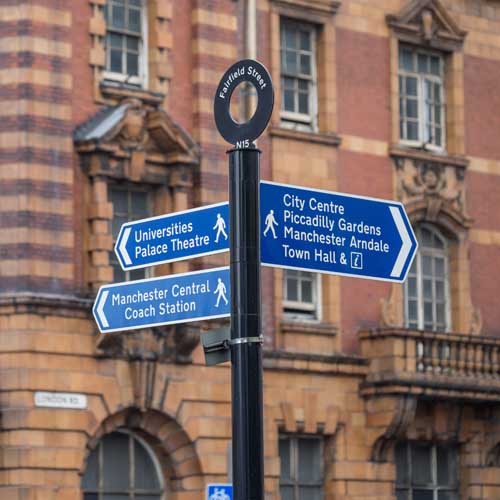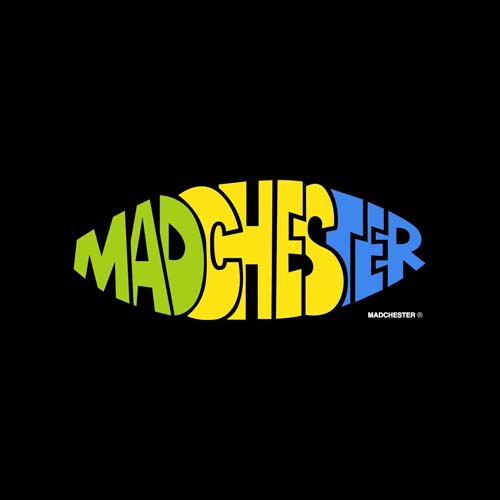Manchester’s libraries are an essential part of the city’s cultural and intellectual landscape. They offer a wealth of resources to people of all ages and backgrounds, including books, magazines, newspapers, and digital media. Manchester’s libraries provide a space for people to learn, explore, and connect with others, and they play a crucial role in promoting literacy, lifelong learning, and community engagement.
Libraries in Manchester also provide access to specialised collections and archives that preserve the city’s history and cultural heritage. For example, the Manchester Central Library houses the Henry Watson Music Library, which holds one of the largest collections of music scores and recordings in the UK. The Portico Library, on the other hand, has a collection of over 25,000 rare and historic books, manuscripts, and artworks, including works by local writers and artists.
In addition to their collections, Manchester’s libraries also offer a variety of programs and events, such as author talks, workshops, and book clubs. These events bring people together and create opportunities for learning and social interaction.
Overall, the importance of Manchester’s libraries cannot be overstated. They are vital resources that provide access to information and knowledge, promote community engagement, and preserve the city’s cultural heritage. In a rapidly changing world, libraries remain a constant source of learning, inspiration, and connection, and they play a crucial role in shaping the intellectual and cultural life of Manchester.
Below are our most famous libraries in Manchester and the history behind them.
Manchester Central library
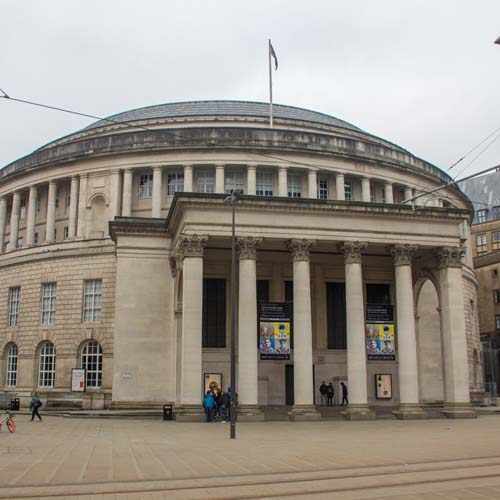
Manchester Central Library is a Grade II* listed building located in the heart of Manchester city centre. The library was designed by E. Vincent Harris, a prominent architect who also designed the Manchester Town Hall Extension which stands right next door. He won two separate competitions to become the architect of both buildings in 1927.The library, first opened in 1934, was the biggest public library in Britain and has since become one of the most iconic buildings in the city. The building’s design is a blend of classical and modernist styles, with a grand entrance hall featuring marble floors and columns, and a large central reading room with a distinctive domed roof.
Manchester Central Library’s collection includes over one million books, as well as newspapers, magazines, and other periodicals. The library also houses several special collections, including the Gaskell Collection, which contains the personal papers and manuscripts of the famous Victorian author Elizabeth Gaskell.
In addition to its extensive collection of books and other materials, Manchester Central Library is also home to several exhibition spaces and event spaces. The library hosts a variety of events throughout the year, including talks, lectures, and exhibitions.
On the stairway sits The Reading Girl which was sculpted by Giovanni Ciniselli and bought by the first Chairman of the Manchester Ship Canal Company, Daniel Adamson, as a gift for the library.
One of the library’s most famous features is its Shakespeare Hall, which is a large performance space located on the ground floor of the building. The hall has played host to countless performances over the years, including plays, concerts, and other cultural events.
In recent years, Manchester Central Library has undergone a major renovation and refurbishment, which was completed in 2014. The renovation included the restoration of many of the building’s original features, as well as the addition of new spaces and facilities.
The library’s exterior was also refurbished, with the building’s distinctive domed roof being repainted in its original green and gold colours.
Manchester Central Library should certainly be on your itinerary for any visit to Manchester.
John Rylands Library
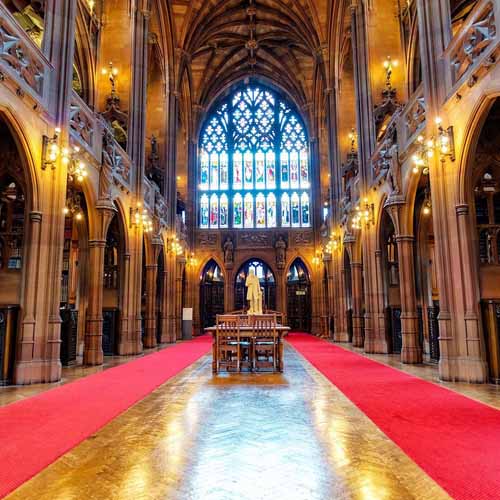
The John Rylands Library is one of the most iconic and historic buildings in Manchester, if not the whole of England. Located on Deansgate in the heart of the city centre, the library is a stunning example of neo-Gothic architecture and a testament to the city’s rich cultural heritage.
The library, sometimes referred to as ‘the Taj Mahal of Manchester’ was founded in 1899 by Enriqueta Rylands in memory of her husband, John Rylands. John Rylands was a wealthy Manchester textile entrepreneur who had died in 1888, leaving behind a fortune that Enriqueta used to establish the library as a lasting tribute to his memory. His fortune was over £2.45 million and the largest amount ever to be left by a non-aristocrat. It’s also a hit with Harry Potter fans – with its Gothic feel and high-vaulted ceilings, you’ll feel like you’re in the Great Hall!
The building itself was designed by the eminent architect Basil Champneys and is widely regarded as one of his finest works. The design draws heavily on Gothic Revival architecture, with intricate carvings, ornate vaulted ceilings, and stained glass windows featuring prominently throughout the building. The library is constructed with Cumbrian sandstone. The exterior with a dark red brick from Penrith and the interior with a Dalston brick ranging from a sand to pink colour.
The library’s collection is equally impressive, with more than 1.4 million books, manuscripts, and other rare items housed within its walls. The collection includes everything from mediaeval manuscripts and rare incunabula to modern first editions and archival material related to Manchester’s history.
One of the library’s most famous treasures is the Gutenberg Bible, one of the earliest printed books in the world. The library’s copy of the Gutenberg Bible is one of only a handful in existence, and it is widely regarded as one of the most valuable and significant books in the world.
Another highlight of the library’s collection is the personal papers of famous writers and thinkers such as John Wesley, William Blake, and Elizabeth Gaskell. These papers provide a fascinating insight into the lives and works of these influential figures and are a testament to the library’s commitment to preserving and promoting the written word.
Over the years, the John Rylands Library has become a cultural landmark in Manchester, attracting visitors from around the world who come to marvel at its stunning architecture and explore its vast collection. The library also plays an important role in the city’s cultural life, hosting exhibitions, talks, and other events throughout the year.
In summary, the John Rylands Library is a true gem in Manchester’s cultural crown. Its stunning architecture, vast collection, and rich history make it one of the city’s most important cultural institutions, and its commitment to preserving and promoting the written word is a testament to the enduring value of literature and scholarship.
The Portico Library

The Portico Library was established in 1806 by a group of Manchester businessmen who were interested in promoting education and culture in the city. The founders were inspired by the idea of the great libraries of ancient Greece and Rome, and they sought to create a similar institution in Manchester.
The Portico Library’s collection is diverse and eclectic, with over 25,000 books covering a wide range of subjects, including literature, history, science, and philosophy. The library also houses a collection of rare books and manuscripts, many of which are of significant historical and cultural importance.
The library’s building is an impressive example of neo-classical architecture, with a grand entrance hall, a sweeping staircase, and a series of elegant reading rooms. The building has been carefully preserved over the years, and it remains one of the city’s most beautiful and historic structures.
The Portico Library has played an important role in the cultural life of Manchester since its inception. The library’s reading rooms have been frequented by many of the city’s most prominent intellectuals and cultural figures over the years, including John Dalton, Elizabeth Gaskell, Anthony Burgess and Eric Cantona.
The founding secretary Peter Roget wrote the first English thesaurus here and Dalton wrote about atomic theory. While William Gaskell was its longest serving Chair his wife, and notorious Manchester novelist Elizabeth, would also use the library.
The library has also hosted a variety of cultural events over the years, including lectures, exhibitions, and concerts. In recent years, the library has expanded its cultural programming, with a particular focus on contemporary art and literature.
In addition to its cultural significance, The Portico Library is also an important centre for education and research. The library’s collection is a valuable resource for scholars and researchers in a wide range of fields, and the library’s staff are dedicated to providing expert guidance and support to visitors.
Chetham's Library
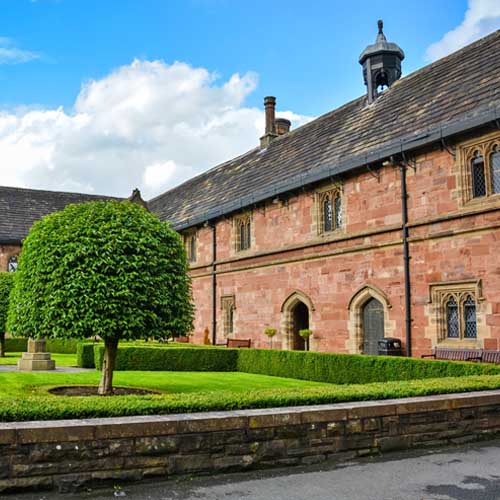
Chetham’s Library is the oldest public library in the English-speaking world and a true Manchester institution. Founded in 1653, the library is housed in a beautiful mediaeval building in the heart of the city, adjacent to Manchester Cathedral.
The library was established by Humphrey Chetham, a wealthy Manchester textile merchant who had made his fortune trading in wool and linen. Chetham was a philanthropist who believed in the power of education and wanted to provide free books to the people of Manchester.
The library’s collection was originally housed in a room above Chetham’s offices, but as the collection grew, it was moved to its current location in a 15th-century sandstone building that had been used as a college for priests in the Middle Ages.
Today, Chetham’s Library is home to more than 100,000 books, manuscripts, and other rare items, including a number of mediaeval manuscripts and early printed books. The library’s collection is particularly strong in the areas of theology, local history, and music, reflecting the interests of the library’s founder and its early supporters.
One of the highlights of the library’s collection is the Manchester Ballad Collection, a unique collection of broadsides and ballads dating from the 17th century to the present day. The collection provides a fascinating insight into the social and cultural history of Manchester and the surrounding area and is a valuable resource for scholars and researchers.
Another notable item in the library’s collection is the “Chetham’s Mediaeval Manuscript,” a 14th-century volume that contains a variety of texts, including a copy of the Anglo-Saxon Chronicle and a poem by Geoffrey Chaucer. The manuscript is considered to be one of the most important mediaeval manuscripts in England and is a testament to the library’s commitment to preserving and promoting the written word.
In addition to its collection, Chetham’s Library is also renowned for its historic building, which features a stunning mediaeval sandstone exterior and a beautiful oak-panelled reading room. The reading room, which was originally used as a chapel by the priests who lived in the building, is now one of the most peaceful and serene spaces in Manchester and a popular spot for scholars and students to study and work.
Over the years, Chetham’s Library has played an important role in Manchester’s cultural and intellectual life, attracting visitors from around the world who come to admire its collection and explore its historic building. The library also hosts a variety of cultural events throughout the year, including concerts, lectures, and exhibitions, which help to showcase the library’s collection and promote its educational mission.
Chetham’s School of Music surrounds the Library and produces fine musicians who can play an array of instruments to an extremely high standard. Beginning in 1653 the school was set up to help poor boys from the area for over 400 years. Since 1969 it has been a co-educational music school for girls and boys.
Some of their successful alumni include Ann Morfee and Jennifer Pike. Ann Morfee has been involved in Classical, Pop and Show music as an acclaimed violinist since 1992. Ann has played with Oasis at their legendary Maine Road concert in 1996 and is on the film There and Then documenting the event. She also features on Unplugged with Jimmy Page and Robert Plant from Led Zeppelin. Jennifer Pike played violin professionally with the Hallé orchestra at 11 and, aged 12, she became the youngest-ever winner of the BBC Young Musician of the Year. Jennifer became the only classical artist ever to win the South Bank Show/Times Breakthrough Award. Playing with well over a dozen orchestras and on as many albums Jennifer is a world class violinist described by The Independent newspaper as “simply spectacular.”
Just a few more of their esteemed alumni include actors and musicians such as Max Beesley Jr, Jack Wolfe and Omar. Max has played keyboards and percussion with Take That and Jamiroquai. He performed with Robbie Williams at Knebworth in 2003. His acting career started in 1983 on Last of the summer wine and continues to this day. Jack Wolfe has worked with the Royal Shakespeare Company and the National Theatre and acted in feature film The Magic Flute, released in 2022. Omar Christopher Lye-Fook MBE, professionally known as Omar is a multi-instrumentalist who is probably best known for his 1991 UK chart hit “There’s Nothing Like This” and has collaborated with lots of musicians including Stevie Wonder. In 2022 Omar played the part of Avery Baker in Eastenders.
Karl Marx often also travelled to Manchester where, during the summer of 1845, he and Engels established a routine of studying together at a table in the alcove of the Reading Room. So when you visit here you can also sit in their seats and imagine the two of them here.
Conclusion
Conclusion
You can see that Manchester is blessed with many unique, historical and fascinating libraries.
So tell us, which is your favourite Manchester library and why?
